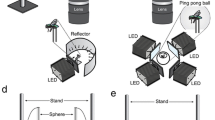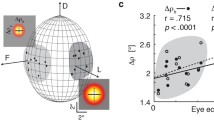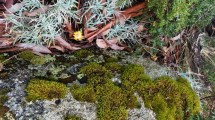Abstract
This study examines the visual acuity of Queensland fruit flies (Bactrocera tryoni) by analysing their turning responses to an immersive visual stimulus consisting of a pattern of vertical stripes presented at various angular periods and rotational rates. The results infer that these flies possess an interommatidial angle of approximately \({2}^{\circ }\), and an ommatidial acceptance angle of approximately \({1.72}^{\circ }\). This suggests that the visual acuity of Queensland fruit flies is substantially better than that of the classical vinegar fly (Drosophila melanogaster), and is comparable to those of the housefly (Musca domestica) and the honeybee (Apis mellifera). The contrast sensitivity of Queensland fruit flies is comparable to that of the housefly.





Similar content being viewed by others
References
Baird E, Boeddeker N, Ibbotson MR, Srinivasan MV (2013) A universal strategy for visually guided landing. Proc Natl Acad Sci 110(46):18686–18691
Barlow HB (1952) The size of ommaditia in apposition eyes. J Exp Biol 29(4):667–674
Borst A (2009) Drosophila’s view on insect vision. Curr Biol 19(1):R36–R47
Buchner E, Götz KG, Straub C (1978) Elementary detectors for vertical movement in the visual system of Drosophila. Biol Cybern 31(4):235–242
Caves EM, Brandley NC, Johnsen S (2018) Visual acuity and the evolution of signals. Trends Ecol Evol 33(5):358–372
Chakravarthi A, Rajus S, Kelber A, Dacke M, Baird E (2018) Differences in spatial resolution and contrast sensitivity of flight control in the honeybees Apis cerana and Apis mellifera. J Exp Biol 221(20):jeb184267
Chiappe ME, Seelig JD, Reiser MB, Jayaraman V (2010) Walking modulates speed sensitivity in Drosophila motion vision. Curr Biol 20(16):1470–1475
de Salomon CH, Spatz HC (1983) Colour vision in Drosophila melanogaster: wavelength discrimination. J Comp Physiol A 150(1):31–37
Dvorak D, Srinivasan MV, French AS (1980) The contrast sensitivity of fly movement-detecting neurons. Vis Res 20(5):397–407
Fermi G, Reichardt W (1963) Optomotorische reaktionen der fliege Musca domestica. Kybernetik 2(1):15–28
Geurten BRH, Nordstrom K, Sprayberry JDH, Bolzon DM, O’Carroll DC (2007) Neural mechanisms underlying target detection in a dragonfly centrifugal neuron. J Exp Biol 210(18):3277–3284
Götz KG (1964) Optomotorische untersuchung des visuellen systems einiger augenmutanten der fruchtfliege Drosophila. Kybernetik 2(2):77–92
Götz KG (1965) Die optischen Übertragungseigenschaften der Komplexaugen von Drosophila. Kybernetik 2(5):215–221
Hardie RC (1979) Electrophysiological analysis of fly retina. I: Comparative properties of R1-6 and R 7 and 8. J Comp Physiol A 129(1):19–33
Horridge G (1977) Insects which turn and look. Endeavour 1(1):7–17
Horridge AGA, Marcelja L (1990) Responses of the H1 neuron of the fly to contrast and moving bars. Philos Trans R Soc Lond Ser B Biol Sci 329(1252):75–80
Horridge GA, Mimura K, Hardie RC (1976) Fly photoreceptors. III. Angular sensitivity as a function of wavelength and the limits of resolution. Proc R Soc Lond Ser B Biol Sci 194(1115):151–177
Ibbotson MR (1991) Wide-field motion-sensitive neurons tuned to horizontal movement in the honeybee, Apis mellifera. J Comp Physiol A 168(1):91–102
Kirschfeld K, Franceschini N (1968) Optische eigenschaften der ommatidien im komplexauge von Musca. Kybernetik 5(2):47–52
Kunze P (1961) Untersuchung des bewegungssehens fixiert fliegender bienen. Z Vgl Physiol 44(6):656–684
Land MF (1989) Variations in the structure and design of compound eyes. In: Facets of vision. Springer, Berlin, pp 90–111
Land MF (1997a) The resolution of insect compound eyes. Isr J Plant Sci 45(2–3):79–91
Land MF (1997b) Visual acuity in insects. Annu Rev Entomol 42(1):147–177
Land MF, Nilsson DE (2012) Animal eyes, 2nd edn. Oxford University Press, New York
Laughlin SB, Hardie RC (1978) Common strategies for light adaptation in the peripheral visual systems of fly and dragonfly. J Comp Physiol A 128(4):319–340
Lawson KKK, Srinivasan MV (2017) Flight control of fruit flies: dynamic response to optic flow and headwind. J Exp Biol 220(11):2005–2016
Lawson KKK, Srinivasan MV (2018) A robust dual-axis virtual reality platform for closed-loop analysis of insect flight. In: 2018 IEEE international conference on robotics and biomimetics (ROBIO), IEEE, pp 262–267
May AWS (1963) An investigation of fruit flies (Trypetidae: Diptera) in Queensland. 1. Introduction, species, pest status and distribution. Qld J Agric Sci 20(1):1–82
Muijres FT, Elzinga MJ, Melis JM, Dickinson MH (2014) Flies evade looming targets by executing rapid visually directed banked turns. Science 344(6180):172–177
Nyquist H (1928) Certain topics in telegraph transmission theory. Trans Am Inst Electr Eng 47(2):617–644
Olberg RM (2012) Visual control of prey-capture flight in dragonflies. Curr Opin Neurobiol 22(2):267–271
Posnien N, Hopfen C, Hilbrant M, Ramos-Womack M, Murat S, Schönauer A, Herbert SL, Nunes MDS, Arif S, Breuker CJ, Schlötterer C, Mitteroecker P, McGregor AP (2012) Evolution of eye morphology and rhodopsin expression in the Drosophila melanogaster species subgroup. PLoS One 7(5):e37346
Rayleigh L (1879) XXXI. Investigations in optics, with special reference to the spectroscope. Lond Edinburgh Dublin Philos Mag J Sci 8(49):261–274
Reichardt W (1969) Movement perception in insects. In: Reichardt W (ed) Process Opt Data Org Mach. Academic Press, London, pp 465–493
Reichardt W (1973) Musterinduzierte Flugorientierung. Naturwissenschaften 60(3):122–138
Serres JR, Masson GP, Ruffier F, Franceschini N (2008) A bee in the corridor: centering and wall-following. Naturwissenschaften 95(12):1181–1187
Snyder AW (1979) Physics of vision in compound eyes. In: Autrum H (ed) Comparative physiology and evolution of vision in invertebrates. Photoreceptor, vol 5. Springer, Berlin, pp 225–313
Snyder AW, Stavenga DG, Laughlin SB (1977) Spatial information capacity of compound eyes. J Comp Physiol A 116(2):183–207
Somanathan H, Warrant EJ, Borges RM, Wallen R, Kelber A (2009) Resolution and sensitivity of the eyes of the Asian honeybees Apis florea, Apis cerana and Apis dorsata. J Exp Biol 212(15):2448–2453
Srinivasan MV, Bernard GD (1975) The effect of motion on visual acuity of the compound eye: a theoretical analysis. Vis Res 15(4):515–525
Srinivasan MV, Dvorak DR (1980) Spatial processing of visual information in the movement-detecting pathway of the fly. J Comp Physiol A 140(1):1–23
Srinivasan MV, Lehrer M (1988) Spatial acuity of honeybee vision and its spectral properties. J Comp Physiol A 162(2):159–172
Srinivasan MV, Chahl JS, Weber K, Venkatesh S, Nagle MG, Zhang SW (1999) Robot navigation inspired by principles of insect vision. Robot Auton Syst 26(2–3):203–216
Srinivasan MV, Zhang SW, Chahl JS, Barth E, Venkatesh S (2000) How honeybees make grazing landings on flat surfaces. Biol Cybern 83(3):171–183
van Breugel F, Dickinson MH (2012) The visual control of landing and obstacle avoidance in the fruit fly Drosophila melanogaster. J Exp Biol 215(11):1783–1798
Wardill TJ, Fabian ST, Pettigrew AC, Stavenga DG, Nordström K, Gonzalez-Bellido PT (2017) A novel interception strategy in a miniature robber fly with extreme visual acuity. Curr Biol 27(6):854–859
Warrant EJ, McIntyre PD (1990) Limitations to resolution in superposition eyes. J Comp Physiol A 167(6):785–803
Wehner R (1981) Spatial vision in arthropods. In: Autrum H (ed) Handbook of sensory physiology. Vol. VII/6C comparative physiology and evolution of vision in invertebrates, vol 4. Springer, Berlin, pp 287–616
Xue H, Zheng L, Wu W (2015) Morphometry of compound eyes of three Bactrocera (Diptera: Tephritidae) species. Fla Entomol 98(2):807–809
Acknowledgements
We thank Gavin Taylor, who provided valuable assistance with setting up the original experimental apparatus. We also thank Dean Soccol for the mechanical design of the thrust-yaw measurement system. We especially thank Thelma Peek and the Department of Agriculture and Forestry, Queensland Government for their generous and abundant supply of fruit flies. KL was supported by an Australian Government Research Training Program Scholarship. This research was supported partly by ARC Grant DP 140100914 to MS. We thank the anonymous reviewers for their valuable comments and suggestions for improving the manuscript.
Author information
Authors and Affiliations
Corresponding author
Ethics declarations
Conflict of interest
Authors express that they do not have conflicts of interest to disclose.
Additional information
Publisher's Note
Springer Nature remains neutral with regard to jurisdictional claims in published maps and institutional affiliations.
Appendix: Temporal aliasing of the contrast-frequency response
Appendix: Temporal aliasing of the contrast-frequency response
Here, we provide an additional analysis of the response-versus-contrast frequency data presented in Fig. 4, in which we include the data from the responses measured at commanded contrast frequencies greater than 30 Hz.
As a result of temporal aliasing caused by the 60 Hz refresh rate of the monitors, a grating that is commanded to move at a contrast frequency greater than 30 Hz will appear to move in the opposite direction. If the commanded contrast frequency is \(x\,\hbox {Hz}\), where \(x>{30}\hbox { Hz}\), then the apparent contrast frequency y of the grating will be \(y=(60-x)\,{\hbox {Hz}}\) and the grating will appear to move at an angular velocity of (y / s) deg/s, where s is the spatial frequency of the grating. Ignoring the negative polarity of the response and considering just the magnitude, we can include the data from the responses measured for commanded contrast frequencies \(x>{30}\hbox { Hz}\) by treating them as responses to contrast frequencies of \(y=(60-x)\,{\hbox {Hz}}\).
An augmented version of Fig. 4, which includes the data from the responses to the temporally aliased stimuli, as described in the text
The results of performing the above operation to include the responses to the temporally aliased stimuli are shown in Fig. 6, which shows freshly fitted spline curves to accommodate the additional data. It is evident from this figure that inclusion of the additional data does not change the shapes of the spline-fitted curves or the locations of their peaks in any major way.
It is important to note that, although the refresh rate of the monitors is 60 Hz, there is no 60 Hz flicker in the visual display because the monitors (Dell 2209WA) have LCD screens (Lawson and Srinivasan 2018).
Rights and permissions
About this article
Cite this article
Lawson, K.K.K., Srinivasan, M.V. Contrast sensitivity and visual acuity of Queensland fruit flies (Bactrocera tryoni). J Comp Physiol A 206, 419–428 (2020). https://doi.org/10.1007/s00359-020-01404-y
Received:
Revised:
Accepted:
Published:
Issue Date:
DOI: https://doi.org/10.1007/s00359-020-01404-y





